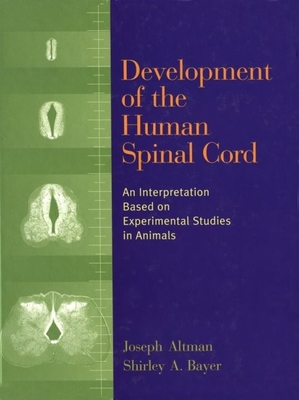You are here
Back to topDevelopment of the Human Spinal Cord: An Interpretation Based on Experimental Studies in Animals (Hardcover)
$270.00
Email for pricing and availability
Email for pricing and availability
Description
There exists a wealth of information about the development of the spinal cord in journal articles and monographs, yet this beautifully illustrated work is the first book devoted to this important topic. Because the developing human spinal cord cannot be subjected to experimental manipulations, the knowledge gained from experimental work in animals is applied here to an interpretation of the time course and mechanisms of spinal cord development in man. The book begins with a review of our current understanding of the structure and functions of the spinal cord. Special reference is made to the phylogeny of the vertebrate spinal cord because the authors' interpretation of the development and organization of the human spinal cord is specifically an evolutionary one. Following a detailed experiment-based account of spinal cord development in the rat, the development of the human spinal cord is described, illustrated and interpreted in separate chapters during three epochs: the first trimester (the embryonic period), the second and third trimesters (the fetal period), and the first year of postnatal life. Special attention is paid to such topics as neurons, and the growth and myelination of the ascending and descending fiber tracts of the spinal cord. The book ends with a correlation of the development of motor behavior with different stages in the morphological development of the human spinal cord during the embryonic, fetal, and postnatal periods. The successive acquisition of voluntary control over different parts of the body during infancy is correlated with the progressive myelination of the corticospinal tract.
* The book contains an extensive review of work on spinal cord organization and development throughout the 20th century.
* The interpretations are based on experimental studies of spinal cord development in the rat carried out by the authors and their associates.
* The histological material on human spinal cord development is the largest ever assembled and reproduced (combining the Carnegie, Minot, and Yakovlev Collections).
* The collected material (which varies in quality and some of it has begun to fade) has been digitized and electronically reprocessed for improved reproduction.
* Discrete components of the spinal cord and new developments are highlighted by color coding; typically on one side only, leaving the contralateral side untouched to allow the reader to use his own interpretation.
* Summary graphs are presented, many in color, to convey important structural relationships, developmental events, or theories.
* The authors revive a few forgotten theories and offer several new ones regarding the development and organization of the human spinal cord.
Development of the Human Spinal Cord will be of interest to developmental biologists, neuroscientists, embryologists, molecular biologists (those working on stem cell research), pediatric neurologists, pathologists, child and developmental psychologists, and their students and trainees.
